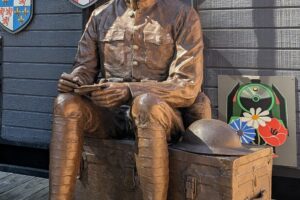Since we were staying at Kings Bay, a submarine base, we thought that a visit to a submarine museum would be perfect. St. Marys is a lovely little city along the coast of Georgia with a ferry ride to famous Cumberland Island that only allows walking, biking, and is a home to horses that always stay there. As a reminder, here’s a map showing you where we are.



The last few posts have Charleston’s Patriots Point become personal for us because the information has been so descriptive and because we lived through the time period. Today’s walk through the museum also became personal when we talked with Mike, who was with a group of submariners who come here every year at this time to remember their time underwater and honor those who have passed away.

Since Kings Bay Submarine Base is so close by, this area was home to many of those who visit the museum.


The earliest submarines were named after fierce fish that made their homes underwater.
The first display we saw was for the USS Aspro that was commissioned into the Navy on July 31, 1943, in Maine. It was the first ship named for a fish found abundantly in the upper Rhone River. It took 2.5 months for the fast attack submarine to be built.
The Aspro completed 7 war patrols and earned 7 battle stars for her service. She was used off and on for around 11 years until she was accepted back into the active fleet on June 8, 1957, serving along the west coast.
Part of the movie Battle of the Coral Sea, starring Cliff Robertson, was shot aboard the Aspro in 1959 before it went on deployment to the western Pacific in mid-1959. In 1960 she was re-designated AGSS-309 and resumed her services along the west coast. Finally on November 16, 1962, she became a target and was sunk by another US submarine off of San Diego.


Walt Disney and WWII submarines
Unknown to us, Walt Disney’s artists were instrumental in designing insignias for many of the WWII submarines.

Where the idea of having a submarine battle flag in WWII is a mystery, because before 1942, US submarines didn’t own or display them. During late 1942 or early 1943, it became a tradition to lash a broom to the periscope shears when returning from a successful patrol to indicate a “clean sweep,” or had sunk everything possible.
In 1944, pennants were added to the brooms to indicate the number of kills. A Japanese flag was used for each ship sunk, a solid red circle on a white background (also known as the “meatball flags”) was used for merchant ships, and a rising sun was used for warships. Occasionally these flags were also painted on the sail (per Wikipedia, the sail on a submarine was “the tower-like structure found on the dorsal (topside) surface of submarines”).
This practice soon evolved into the creation of larger, more elaborate flags that included the submarine’s insignia in the center. This insignia, along with symbols showing kills and accomplishments, became a sort of “living history” of the sub’s career.

After the war, all Japanese emblems were removed from patches to be politically correct; soon after the mermaids were removed. When the Los Angeles Class submarines started being built and used, the patches lost their menacing designs since the ships started being named for cities and not fierce fighting fish. Submarines were no longer allowed to have aggressive-looking patches.
In the previous picture, see the difference on the USS Drum original flag and the later battle flag using the Disney logo that was painted on the sail of the submarine.
Hank Porter: Disney’s go-to artist for insignia designs

Porter worked in the animation department working on Snow White and the Seven Dwarfs in 1937. In December he wrote to his father about his animation work in the movie, especially when the Dwarfs left the mine singing their song, when suddenly they stopped, piling up on one another.
In the next picture, the mosquito-on-a-torpedo insignia was on the side of the charthouse of a Navy PT boat, known as the “Mosquito Fleet.” (Per Wikipedia, a charthouse is the “compartment from which the ship was navigated, especially in the Royal Navy.”)

But his most prolific work came for creating more than 1000 insignia and emblems for the various branches of the military, other US Government agencies, and charity organizations involved in the war effort.
The written requests coming to the Disney studios started in 1941 when Lt. E.S, Caldwell in Naval Operations wrote to Walt Disney asking for an emblem for the fleet of PT (patrol torpedo) boats. Disney responded within days with a design of the mosquito insignia in the previous picture. The image, created by Hank Porter, of a little mosquito, streaking through the water with a sailor’s hat on his head holding a torpedo between its “many legs, made such a hit that every torpedo boat in the fleet soon had a Disney mosquito.” The emblem was placed on the side of the charthouse where the boat was piloted from.
other insignias
In 1944, members of a California-based US Navy Construction Battalion (the Seabees) asked the studio for a “deliciously feminine queen bee, with rosebud lips, dewy bedroom eyes and an atomizer to make her deadlier than the male” who carries only a Tommy gun. Porter then created Phoebe, the female Seabee.
Porter came up with the concept and then designed it. Often he created a water color version to give an indication of the color palette. This process was the equivalent of a visual development painting or color script in animation terms.

Another original painting is The Rock Submarine Base at Pearl Harbor that was completed in 1945. The insignia has a striking image of a Rockfish, also known as a grouper, in a sailor’s hat with boxing gloves on its pectoral fins. Porter was able to take a fish and give it anthropomorphic qualities that appear natural and well portioned. The Rockfish has a tough-guy attitude that conveys the message that he’s ready to fight. The painting is finished off with a Walt Disney signature done by Porter.
The Rock drawing refers to the WWII Pacific Submarine Force based at Pearl Harbor that was tasked with wreaking havoc on Japanese shipping and troops transports.
Many other creative insignias were designed for submarines during the war that brought a little levity into the horrors of war.

ship mascots
Years ago on a trip we learned that ships often had mascots on board, especially dogs. Today we learned that the USS Skate had a roster! A group of sailors decided to visit a zoo during R&R. They noticed baby chicks running around, so one of the sailors stole one and brought in on board the sub as a pet.


So what’s so important about the USS Skate that the following picture is in the museum?

Per Wikipedia, “Sir George Hubert Wilkins (31 October 1888 – 30 November 1958), commonly referred to as Captain Wilkins, was an Australian polar explorer, ornithologist, pilot, soldier, geographer and photographer. He was awarded the Military Cross after he assumed command of a group of American soldiers who had lost their officers during the Battle of the Hindenburg Line (WWI), and became the only official Australian photographer from any war to receive a combat medal. He narrowly failed in an attempt to be the first to cross under the North Pole in a submarine, but was able to prove that submarines were capable of operating beneath the polar ice cap, thereby paving the way for future successful missions. The US Navy later took his ashes to the North Pole aboard the submarine USS Skate on March17, 1959.”
On August 3, 1958, the new Nautilus became the first ship to reach the North Pole, sailing from the Bering Straits to Norway on a course identical to the one planned by Wilkins. Less then a year later, on March 17, 1959, the USS Skate (SSN-578) became the first submarine to surface at the pole.
Barney said he knew about the Nautilus but not about the Skate. Now we know the story behind the picture.
history of submarine dolphins
The insignia of the US Submarine Service is a submarine flanked by 2 dolphins. Dolphins were attendants to Poseidon, Greek god of the sea and patron deity to sailors. Sometimes they are referred to as the sailor’s friend.

On June 13, 1923, Captain King, who was pretty high up in the Navy, suggested to the Secretary of the Navy that a distinguishing device for qualified submariners be adopted. He submitted his own pen-and-ink sketch showing a shield mounted on the beam ends of a submarine, with dolphins forward of, and behind, the conning tower. Over the next couple of months, The Bureau of Navigation solicited additional designs from several sources. Some combined a submarine with a shark motif, others showed submarines and dolphins, and still others used a shield design.
Eventually 2 designs were submitted (one of which was the 1926 class crest from the Naval Academy) to the Bureau of Navigation, and they combined them into a single concept (see examples following this history).

Today the original design created by Bailey, Banks & Biddle (BB&B), a Philadelphia firm, is used by many manufactures without modification, while others choose to take some artistic license, especially in updating the class of submarine depicted since the first one on the design was from an “O” class submarine.
Originally the submarine insignia was to be worn at all times by officers and men qualified in submarine duty attached to submarine units or organizations, ashore and afloat. When not attached to such units, the insignia couldn’t be worn. In 1941, the Uniform Regulations were modified to permit officers and men qualified who were eligible to wear the submarine insignia after they had been assigned to other duties in the naval service, unless such right had been revoked.
The officer’s insignia was a gold metal pin worn centered above the left breast pocket and above the ribbons and medals. Enlisted men wore the insignia, embroidered in silk: white silk for blue clothing and blue silk for white clothing. Their insignia was sewn on the outside of the right sleeve, midway between the wrist and elbow. The insignia was 2-3/4 inches long.

This change allowed “Enlisted men, who are qualified and subsequently promoted to commissioned or warrant ranks, may wear enlisted submarine insignia on the left breast until they qualify as submarine officers, at which time this insignia would be replaced by the officers” submarine pin. Seamstresses were kept busy.



safety


The USS Cavalla had this Escape Procedure.

- A. First team enters and recheck rigging
- B. Turn on battle lanterns
- C. Shut and dog lower hatch
- D. Don escape Appliances
- E. Hook up charging hoses: cycle master stop valve and breathe through snorkel
Glad they were so well organized!
plaques and insignias
As we’ve seen, submariners are proud of what they do and who they work with.


The next post covers the history of submarines in the US Navy, types of submarines, and support ships. We even get to see a famous red chair from Hunt for Red October.




